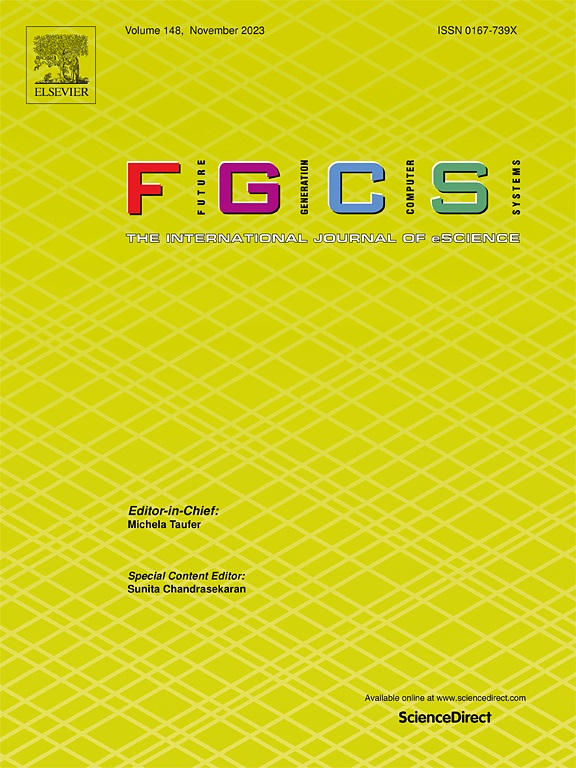LSDMA:云计算中分层安全驱动的截止日期约束多工作流分配模型
IF 6.2
2区 计算机科学
Q1 COMPUTER SCIENCE, THEORY & METHODS
Future Generation Computer Systems-The International Journal of Escience
Pub Date : 2025-05-30
DOI:10.1016/j.future.2025.107941
引用次数: 0
摘要
安全性和截止日期敏感性在许多云应用程序中起着至关重要的作用,需要高级别的安全性来确保跨平台数据传输中的机密性、完整性和身份验证。为此,设计了一种安全驱动的期限约束多工作流分配(LSDMA)模型,以优化满足工作流任务安全需求和期限约束的风险概率。为了保证云平台的安全,采用了认证、完整性、机密性三级安全服务。然而,现有的安全工作流分配文献中很少有针对多个工作流处理安全性和截止日期需求的模型。它留下了在领域中开发新模型的空间。此外,通过使用分层分配、在空闲间隙中插入最合适的后续任务以及在执行期间采用分层之间的并行通信机制来减少总体通信开销,也改进了工作流的完成时间。在MATLAB中设计并实现了安全工作流分配器的原型模拟器,并与该领域的竞争模型进行了性能评估。细致的仿真结果表明,在考虑QoS参数的情况下,LSDMA模型在随机工作流批处理和实际工作流批处理上都优于现有模型。实验结果表明,LSDMA在风险概率方面优于SDS、LBSIR、SAHEFT、SODA和HEFT,在随机、蒙太奇、CyberShake和LIGO工作流程的批处理上分别实现了21% - 73%、15% - 74%、12% - 72%和14% - 73%的改进。本文章由计算机程序翻译,如有差异,请以英文原文为准。
LSDMA: Levelized security driven deadline constrained multiple workflow allocation model in cloud computing
Security and deadline sensitivity play a crucial role in many cloud applications, requiring a high level of security to ensure confidentiality, integrity, and authentication in cross-platform data transmission. Therefore, we designed a levelized security driven deadline constrained multiple workflow allocation (LSDMA) model in order to optimize the risk probability of satisfying the workflow tasks’ security demands and deadline constraints. To ensure the security in cloud platform, three-level security services, i.e., authentication, integrity, and confidentiality, are employed. However, existing secured workflow allocation literature reports very few models for multiple workflows addressing security and deadline requirements. It leaves scope to develop new models in the domain. Further, the completion time of the workflows is also improved by using level-wise allocation, inserting best-fit successor tasks into idle gaps, and adopting a parallel communication mechanism between levels during execution to reduce overall communication overhead. The prototype simulator for the secured workflow allocator is designed and implemented in MATLAB for performance evaluation with the competitive models from the domain. The meticulous simulation results show that the LSDMA model outperforms at both batch of random workflows and real workflows among the state-of-the-art models on the considered QoS parameters under study. The experimental findings indicate that LSDMA surpasses SDS, LBSIR, SAHEFT, SODA, and HEFT regarding the risk probability, achieving improvements of 21 %–73 %, 15 %–74 %, 12 %–72 %, and 14 %–73 % when varying the batch of random, Montage, CyberShake, and LIGO workflows, respectively.
求助全文
通过发布文献求助,成功后即可免费获取论文全文。
去求助
来源期刊
CiteScore
19.90
自引率
2.70%
发文量
376
审稿时长
10.6 months
期刊介绍:
Computing infrastructures and systems are constantly evolving, resulting in increasingly complex and collaborative scientific applications. To cope with these advancements, there is a growing need for collaborative tools that can effectively map, control, and execute these applications.
Furthermore, with the explosion of Big Data, there is a requirement for innovative methods and infrastructures to collect, analyze, and derive meaningful insights from the vast amount of data generated. This necessitates the integration of computational and storage capabilities, databases, sensors, and human collaboration.
Future Generation Computer Systems aims to pioneer advancements in distributed systems, collaborative environments, high-performance computing, and Big Data analytics. It strives to stay at the forefront of developments in grids, clouds, and the Internet of Things (IoT) to effectively address the challenges posed by these wide-area, fully distributed sensing and computing systems.

 求助内容:
求助内容: 应助结果提醒方式:
应助结果提醒方式:


